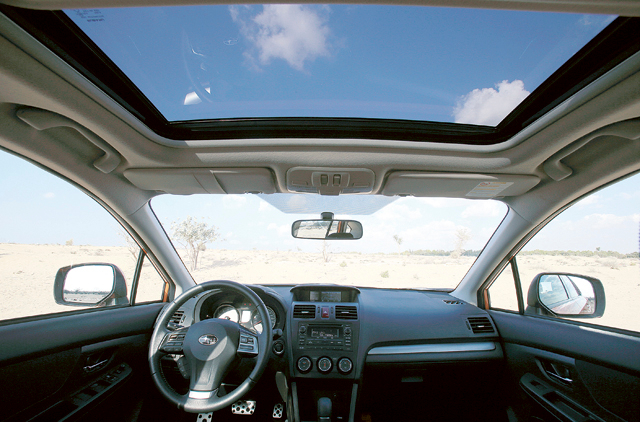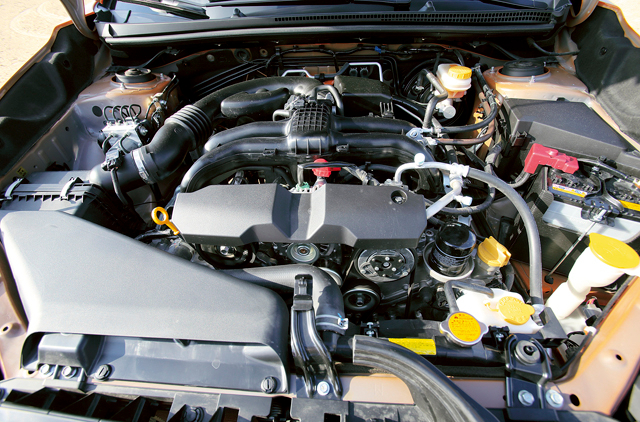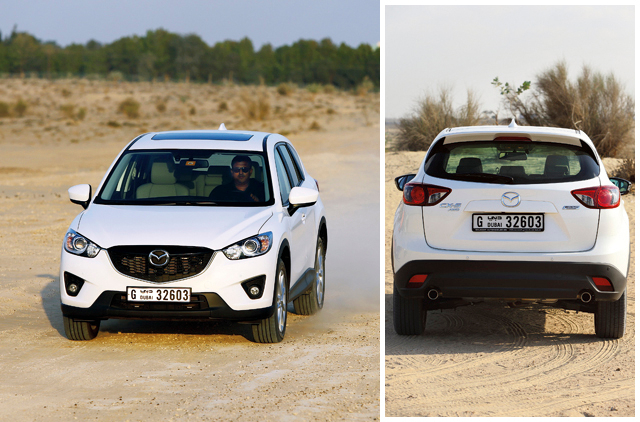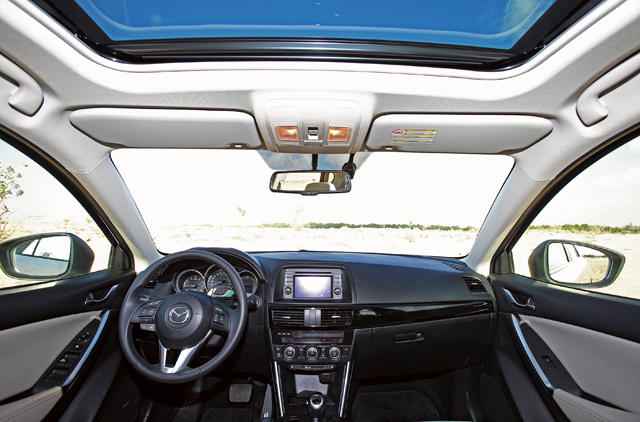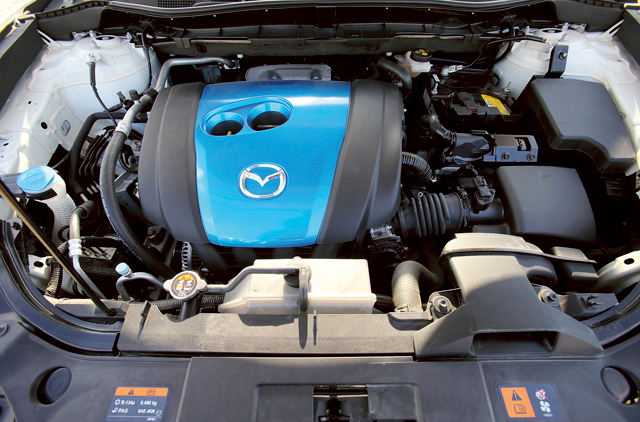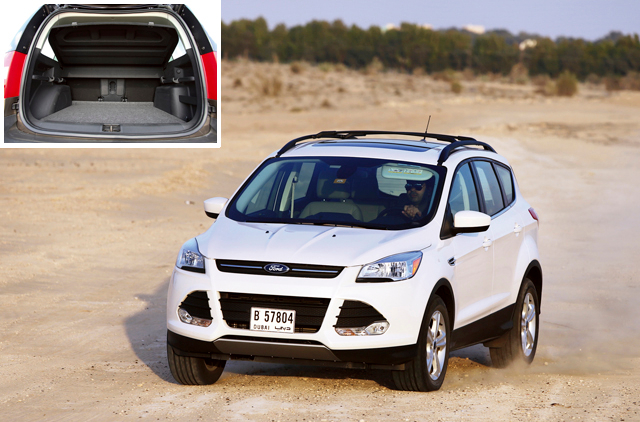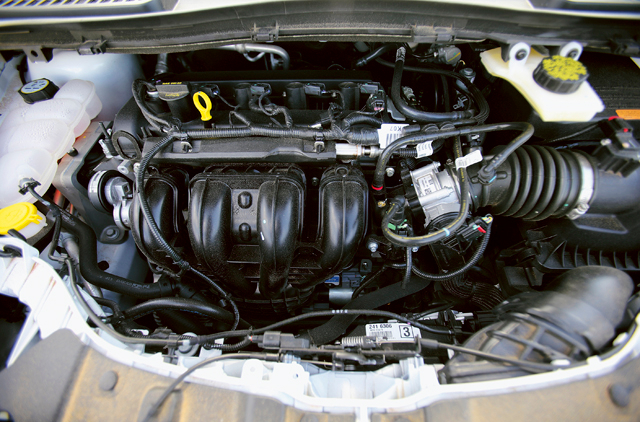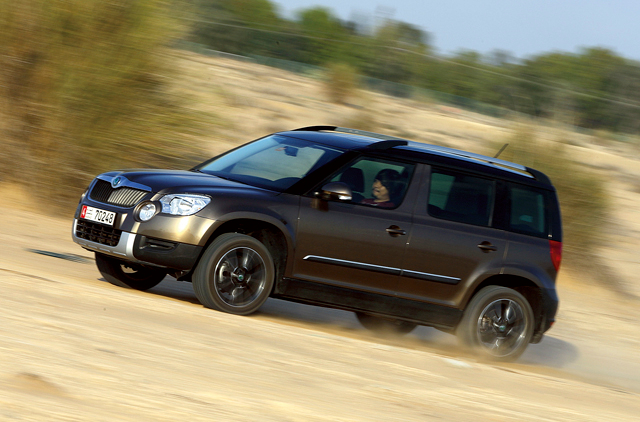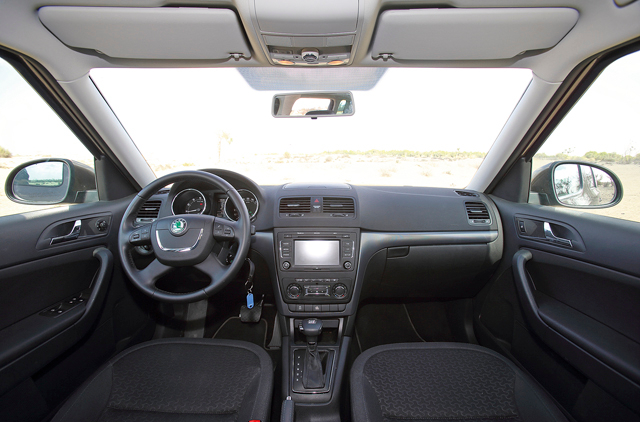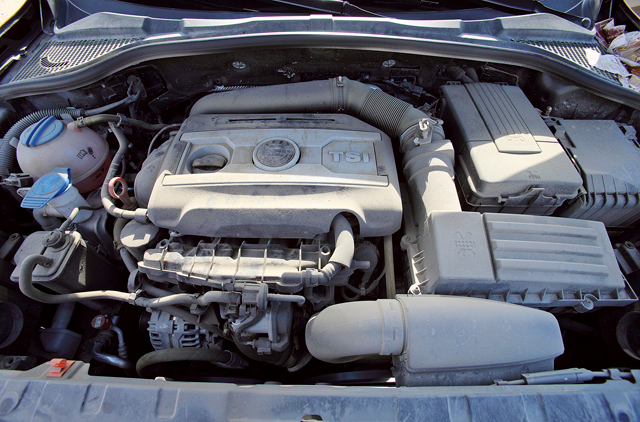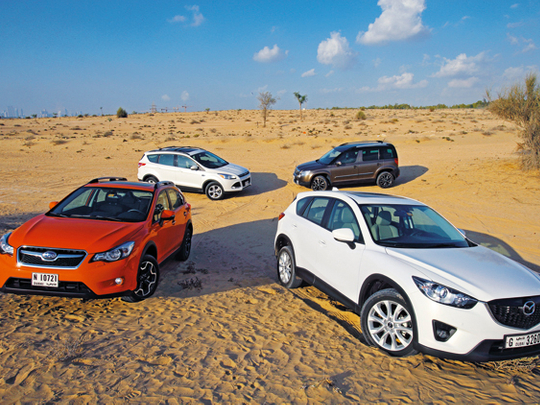
At last count, there were a staggering 37 crossovers available to GCC buyers spanning price ranges from Dh50K all the way well past 200 grand (and more, if you go mental with German makers’ options lists). Well, we couldn’t fit 37 cars on our cover (hopefully the 18 cars we jam-packed on to the cover of our wheels CotY issue were pleasing enough) let alone get them all together, nor would Dh50K Renault Dusters going up against loaded Infiniti FX50s be a meaningful gathering.
So we kept it simple: the latest, greatest crossovers in the most crowded corner of the segment — the Dh95K-Dh115K range. That means we called up Skoda, yet again, asking for the Yeti, yet again, and then persuaded three other carmakers to let us pit their new offerings against the wheels Crossover of the Year. Could the multi-talented and endearing Skoda maintain its foothold in this class? Or would the Subaru XV or the newly launched Ford Escape and Mazda CX-5 dethrone the little prince?
Dejan’s Subaru XV
Subaru loves to boast about its boxer engine’s qualities, such as a lower centre of gravity, better economy in part with improved aerodynamics through lower frontal areas, and the undersquare dimensions of its cylinders. The 2.0-litre boxer four fitted in the XV crossover banks on a long-stroke configuration to maximise torque, but 196Nm is by far the lowliest figure here, with even the naturally aspirated 2.0-litre Mazda eclipsing that.
It’s the least powerful in this gathering too, with 148bhp peaking at 6,800rpm, the heady heights of which you’ll never reach thanks to the demotivating drone of the continuously variable transmission. But instead of me droning on about the subject, we’ll leave the XV with the conclusion that it’s plain and simply slow.
The engine loves a workout about as much as your average Trekkie and, provided you come prepared with earplugs, you may reach 100kph from rest in 10.7 seconds and go on to 187kph, with a tailwind. How about that lower centre of gravity, though, right? The XV is basically an Impreza with a raised ride height and Subaru’s awesome all-wheel drive system, meaning this thing rides and handles with the composure of, well, an Impreza. It’s quite possibly the most car-like crossover here, which is saying a lot considering the Yeti and CX-5 are part of the shoot-out.
Since the CVT is the only transmission available in the GCC, the model comes with an Active Torque Split system capable of transferring all the power to where it’s needed, on order of the electronically managed transfer clutch which measures acceleration, deceleration, and traction. With traction control off, the XV is killer off-road, making light work of sandy trails,
rocky terrain, steep climbs and basically everything this side of full-on dune bashing.
Its generous approach and departure angles and plastic cladding protecting the bright paintwork also mean you can hit ruts head on and allow the supple suspension and meaty tyres over 17in wheels to cushion the ride. Inside, the XV can’t match the premium Ford for the quality of materials and equipment levels, but it’s sensible and comfortable, with plenty of rear legroom and a flat cargo floor. If it wasn’t for the below-average fuel economy we got on a long-term average with the boxer motor, and the frankly rubbish CVT, this XV would’ve valiantly challenged the Yeti for our wheels Crossover of the Year award.
Sony's Mazda CX-5
At a time when every carmaker is working overtime to fill niches and create new ones within the lucrative SUV segment, Mazda’s CX-5 could well seem to be just an attempt at completing the brand’s SUV range, which also includes the CX-9 and the CX-7. However, the new compact crossover is much more than that; it offers the first glimpse into Mazda’s future, especially their much-touted Skyactiv technology. It’s also designed afresh from the ground up rather than being based on any existing platform.
Unlike its sleek and modern-looking big brothers, the CX-5 gets more of a bland, upright design, making it hard to believe it is an all-new model. The overall design follows the new “Kodo — soul of motion” philosophy, which all future models in the brand’s line-up will follow. Much like the exterior, the cabin is plain and basic, but laid out in a way that makes every control accessible and easy to use, and the plastics and leathers are of high quality. It feels as roomy as the CX-7, comfortably seating four adults and there’s even enough space to squeeze in a fifth at the back.
Power comes from 2.0-litre inline-four rated at 155bhp, mated to a six-speed automatic transmission. A major factor in the host of features that make up Skyactiv, the four-pot combines decent acceleration with extremely good fuel-economy figures, thanks to the high 13.0:1 compression ratio, direct injection and variable intake- and exhaust-valve timing. In comparison to Mazda’s previous 2.0-litre four-cylinder engine, this one offers up to 15 per cent more low- to mid-range torque, and is 15 per cent more fuel efficient. During our test drive, we got average figures as low as 6.5 litres-per-100km.
On the road, the CX-5 impresses with its agility and crisp steering, with drive characteristics that are almost as involving and lively as that of the Yeti. However, the ride quality is not the best in class, lacking the refinement of rivals like the Ford Escape. It’s got all the features you’d come to expect in such a car, including dual-zone automatic climate control, a rear-view camera, a 5.8in screen, and regular fare like Bluetooth, USB and so on. Overall, just like the Skoda, the CX-5 is a crossover that is capable of converting even the most serious SUV-haters with its clever blend of fun and practicality.
Imran's Ford Escape
As makeovers go, this is a pretty drastic one. The previous Escapes used to look rugged and boxy and this attracted many to Ford’s crossover; it was hunky. But all that has changed. Sleek and svelte describes the 2013 model best. It’s rounder and softer than ever before and resembles the Focus, which is also a handsome looker. Ford’s ‘kinetic’ design language seems to have gone into overdrive here. The exterior boasts a neat character line that runs from the front fenders to the rear end, it wears 17in alloys and packs a rear spoiler, making the Escape hard to miss.
The interior offers plenty of room (drop the back seat and you have 1,920 litres of boot space) and is very comfortable, but the dash may have benefited had it been a tad less cluttered. The materials in the cabin are all top notch and the leather seats are very well padded and comfortable — you really wouldn’t mind long journeys in here. In fact, you’d look forward to them, especially since you get the revised MyFord Touch with Sync infotainment system, which has been simplified and is now far more intuitive.
The new model is loaded with a host of safety technology including ABS, seven airbags and a Blind Spot Warning system. Powering the Escape is a 2.5-litre four-cylinder motor that produces 168bhp at 6,000rpm and 230Nm of torque at 4,500rpm. It’s a strong engine and gets you up and running very quickly; 0-100kph takes just 9.4 seconds and top speed is 190kph. The four-pot has been mated to a six-speed automatic — a decent gearbox that shifts smoothly — which sends the grunt to the front wheels. Though it doesn’t have steering-mounted paddles, you do get a thumb-actuated button (Select Shift) on the lever, which isn’t as bad as it sounds.
The best thing about the Escape is its driving dynamics; it is very car-like. It’s almost as if you’re driving a Focus on a set of taller springs and since it weighs just under 1,600kg, it feels nippy and eager. The electric steering has been weighted just right; it isn’t too heavy or light and offers good feedback. It helps make the Escape feel smaller than it is and manoeuvring it in a tight Spinneys car park shouldn’t pose a problem.
Imran's Skoda Yeti
It hasn’t even been a month since the Skoda Yeti was awarded the honour of being our crossover of the year in our CotY issue and we’re already pitting it against three fierce rivals to see whether it’ll sink or swim. This quirky looking thing has some serious competition to contend with here, but it needn’t be worried for the Yeti has plenty going for it, such as those rugged looks. No bigger than the Volkswagen Golf on which it is based, the Skoda sits tall; it looks a little uneasy at first but you soon grow used to the gimmicky styling. Because of the high roof and upright seating position, it boasts incredible leg and headroom making it comfortable for long journeys.
Interior space is impressive to say the least, even in the second row and the build quality is top notch; the chunky steering wheel is a particular delight while the switchgear and general fit and finish deserve praise. Being powered by VW Group’s 160bhp 1.8-litre TSi motor, which combines direct injection and a turbocharger, ensures a nippy ride. The power delivery is smooth, the engine is quiet and the six-speed DSG twin-clutch automatic shifts exceptionally quickly. It rides very well both on and off-road even though it isn’t a car designed to be thrashed, you can’t help but do just that.
There is hardly any lag and it never stops feeling refined. And when you go off-roading, you will be properly surprised at how capable it is. Boasting a new-generation Haldex 4 drivetrain, it makes the Yeti quick to react, easy to manoeuvre and most importantly, lots of fun. The ABS acts a bit like hill descent control by braking individual wheels and allowing it to creep down inclines with ease.
However, there is some flex in the chassis and the boxy Skoda sounds like it’s falling apart at the seams when you venture out into the rough. It leans a little in the corners because of those high springs but in general, it grips and handles very well. Those looks won’t appeal to everyone and perhaps it’s still not cool to own a Skoda, but it scores highly in terms of comfort, performance and ability. Read our verdict on the next page to find out how it fared against the others…
VERDICT
A crossover is a sensible choice you make at the behest of your significant other, or because your kids keep spilling OJ and smattering peanut butter all over your sportscar. Enough! It’s time to buy a dispensable family car, you say… So a crossover shouldn’t endear itself to you, but rather simply fill a requirement and then make way for the next vehicle three or five years down the line. And that’s why we love the Skoda Yeti so much — not only does it have an excellent turbocharged VW Group engine mated to the even-better DSG, atop a capable all-wheel drive chassis that can stamp its authority on mountain trails, but you also can’t help but get emotionally attached to this curious car.
It won’t be just a family crossover; it will be your faithful family pet standing guard on the driveway at night, loyally accompanying you on every road trip and camping trip. It helps that it’s great value too. The Skoda Yeti remains our favourite crossover, but it’s only just managed to fight off the great effort from Subaru’s XV, which is ruined by its powerplant and CVT, while the Escape loses this shoot-out simply because it’s too expensive for a front-wheel drive.
That leaves the Mazda CX-5 to grab the second-best spot, thanks to a thoroughly good car chassis with impeccable road manners. The Skyactiv engine affords the Mazda excellent fuel economy as we averaged 6.5-litres per 100km, despite the fact that the GCC-spec cars can’t quite muster up all the claimed Skyactiv goodies. It’s only let down by a somewhat ordinary interior and high price. So, while the Escape and XV can subjectively fight for third place, the CX-5 misses out on the top spot thanks to a loveable and domesticated furry animal they call the Yeti.



